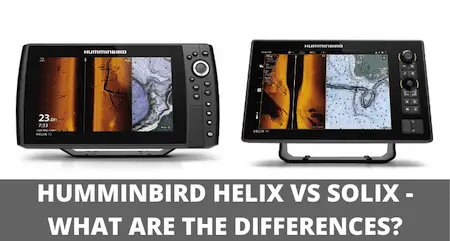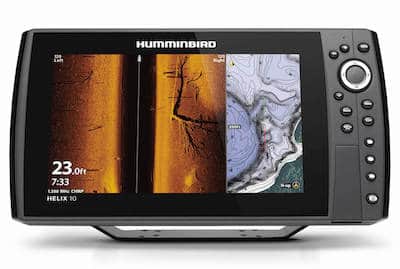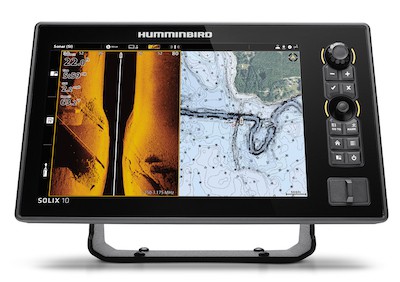What Is The Difference Between Humminbird Helix And Solix?
UPDATED 03 NOVEMBER 2023
by Robert Ceran
This article may contain affiliate links. If you make a purchase after clicking on a link we may earn a small commission at no extra cost to you.
The Helix series has long been the flagship lineup of Humminbird fish finders, but in 2017 the company launched a new high end series called Solix.
Solix models have many similarities to Helix models, including identical display size and sonar capabilities. So what are their differences, and which model is best for your purposes?
For this article my team and I tested both fish finder series and compared them side by side. We’ll go over our findings and their most important differences, to help you choose the best model for your purposes.

Humminbird Helix vs Solix series compared side by side
The table above compares the most important specs and features of two Helix 10 models with two Solix 10 models of same size and sonar capability that we tested.
As you can see, the biggest differences lie in the functionalities connected to the screen.
Now let’s dive into the details and take a closer look at the main differences between the two series.
The most important differences between the Humminbird Helix and Solix series
Touchscreen functionality: This is the first area with big differences between the two lineups.
Simply put, Solix models have touchscreen functionality, while Helix models don’t. Both lineups also have buttons for controlling screen view.
Bottom line: Our testing showed that the touchscreen functionality of Solix models gives users more inuitive control of what they view on the screen, which helps to take full advantage of the powerful sonar and mapping capabilities side by side on a split screen.
Screen resolution: While both series have an identical display size, Solix models have a higher screen resolution with 1280 x 800 pixels, while Helix models have 1024 x 600 resolution.
Bottom line: When we tested it, we found that the higher resolution of Solix models provides higher quality images on the display screen.
Screen view customization: While the screen view on Helix models is fixed, it can be customized on Solix models.
In other words, you can decide which combination of sonar and mapping data you want to display at any one time, and with which relative sizes.
For example, if you want to display side imaging most prominently, while ignoring down imaging, and combine that with mapping data in a smaller window, you can do that – or any other combination you prefer.
Bottom line: The Solix screen view is fully customizable (unlike Helix models), and when we put it to the test, we found that this helps to take full advantage of all mapping and sonar functionalities, in an ideal combination for your specific needs.
Transducer grounding: The transducers of Solix models are fully grounded, while those of Helix units are only partially grounded.
During testing we found that the extra grounding reduces signal noise, and generates more crisp and higher quality sonar read outs,
Down imaging: There is no difference between the two series in this category. Down imaging is a standard feature included in all models.
Side imaging: There is no difference between the two series in this category, but there is a difference between different models in each series.
While the Mega DI+ models of both series only have down imaging, the Mega SI+ models of both series have both down imaging and side imaging.
CHIRP: Both series have identical dual spectrum CHIRP sonar technology.
GPS: Both series have identical GPS receiver functionality.
Maps: There is no difference between the two series, which come with preloaded Humminbird base map.
Both series are also fully compatible with both Lakemaster and Navionics maps, which can be loaded via their microSD card slot.
If you’re not sure which of these two lakemap softwares is best for your purpose, check out our article comparing them side by side: Navionics vs Lakemaster.
Now let’s take a look at each of the models in more detail.
Humminbird Helix 10 Mega DI+ GPS G4N

This is a high end model that comes with a large display of 10.1” diagonal size.
Our testing revealed that the generous screen size is extremely helpful in order to use split screen functionality, and to take full advantage of 2D sonar, down imaging, and mapping data side by side.

Features:
- Mega DI+ down imaging
- Humminbird base map
- Bluetooth & ethernet networking capabilities
- AutoChart live chartplotting functionality
Solix 10 Mega DI+ G3

With a 10.1” display, this is the smallest unit in this series, and comes with Mega DI+ down imaging, but without side imaging.
However, it does include touchscreen functionality, higher screen resolution, and a fully customizable screen view.
When we tested it, we found that these features are great for using the large screen to its fullest potential, by displaying the most important data in the ideal proportions for your purposes.

Features:
- 1280p HD resolution
- Cross-Touch touch screen functionality
- Bluetooth & ethernet networking capabilities
- Compatible with Minn Kota trolling motors
Humminbird Helix 10 Mega SI+ GPS G4N

In contrast to the Mega DI, this model also includes side imaging, which is essential for scanning large areas to find promising spots with underwater structure and bait balls.
In addition to the powerful sonar technologies, it also has state of the art mapping capabilities, and can be used with both Navionics and Lakemaster maps.

Features:
- Mega SI+ side imaging
- Bluetooth & ethernet networking capabilities
- Humminbird base map
- AutoChart Live chartplotting
Humminbird Solix 10 Mega SI+ G3

This model combines both side and down imaging with the powerful screen capabilities of this series.
This means you can use the powerful display quality and customization abilities to control your screen view dynamically as your needs change.
A large display size combined with full customization abilities is an essential feature for most pro anglers, and this model provides both of those in crystal clear HD resolution.

Features:
- Cross-Touch interface
- 1280p HD resolution
- Navionics and Lakemaster compatible
- Minn Kota compatible
Conclusion
To summarize: the Solix fish finder series distinguishes itself from the Helix series by having touchscreen functionality, higher screen resolution, and a fully customizable screen view.
Our testing showed that all of these features help to take full advantage of the powerful sonar and mapping capabilities available on Solix units.
However, it’s important to note that the Helix series has identical sonar and mapping capabilities to the Solix series, and thus provides excellent quality in these areas, just with a lower quality screen display.
If you’re planning to use your Solix for Mega 360 imaging, check out our article on which Humminbird Solix works with 360 imaging?
So if the screen features aren’t that important to you, then Helix units have all the important functions covered for you.
To make matters even more complicated, Humminbird released the new Apex series in late 2020, which means you now have three high end lineups to choose from.
If you’re interested to compare these units with a Lowrance model that combines high end sonar and mapping capabilities, take a look at our Lowrance Elite 9 TI review.
Gear and methods used for testing
For consistent testing results, we tested all fish finder units reviewed above with a XM 9 HW MSI T transducer transom mounted on a Ranger Z520R bass boat. We tested all units on the same day on Lake Tarpon, to make sure we could compare their performance side by side under similar conditions. Testing was performed by imaging schools of panfish and bass relating to structure in 5 to 19 feet of water.




